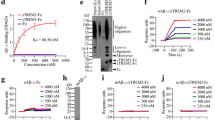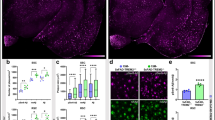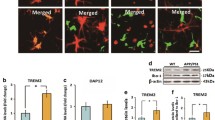Abstract
As the most common type of neurodegenerative disease, Alzheimer’s disease (AD) is characterized by the accumulation of amyloid-β peptide (Aβ) within the brain. Triggering receptor expressed on myeloid cells (TREM) 1 is an immune receptor expressed by mononuclear phagocytes including monocytes and microglia, coupling with TYRO protein tyrosine kinase binding protein to regulate immune reactions. Emerging evidence indicates that rs6910730G, an intronic variant of TREM1, is associated with an increased Aβ neuropathology in the brains of elderly subjects, but the underlying mechanisms remain unclear. Here, using two independent cohorts of healthy individuals, we provided evidence that rs6910730G reduced the ability of human monocytes for Aβ phagocytosis, and this reduction was likely attributed to a decreased monocytic TREM1 expression. By knockdown and overexpression of Trem1 in mouse primary microglia, we showed that TREM1 facilitated microglial phagocytosis of Aβ. In support of this finding, knockdown of Trem1 in the brains of APP/PSEN1 mice increased Aβ1–42 levels and total amyloid burden, whereas selective overexpression of Trem1 on microglia or activation of Trem1 signaling by an agonistic antibody ameliorated Aβ neuropathology and rescued AD-related spatial cognitive impairments. Altogether, these findings uncover the role of TREM1 in microglial Aβ clearance, and establish TREM1 as a potential therapeutic target for AD.







Similar content being viewed by others
References
Benitez BA, ** SC, Guerreiro R, Graham R, Lord J, Harold D et al (2014) Missense variant in TREML2 protects against Alzheimer’s disease. Neurobiol Aging 35(1510):e1519–e1526. doi:10.1016/j.neurobiolaging.2013.12.010
Bliederhaeuser C, Grozdanov V, Speidel A, Zondler L, Ruf WP, Bayer H et al (2016) Age-dependent defects of alpha-synuclein oligomer uptake in microglia and monocytes. Acta Neuropathol 131:379–391. doi:10.1007/s00401-015-1504-2
Burgess N, Maguire EA, O’Keefe J (2002) The human hippocampus and spatial and episodic memory. Neuron 35:625–641
Chan G, White CC, Winn PA, Cimpean M, Replogle JM, Glick LR et al (2015) CD33 modulates TREM2: convergence of Alzheimer loci. Nat Neurosci 18:1556–1558. doi:10.1038/nn.4126
Colonna M (2003) TREMs in the immune system and beyond. Nat Rev Immunol 3:445–453. doi:10.1038/nri1106
Doens D, Fernandez PL (2014) Microglia receptors and their implications in the response to amyloid beta for Alzheimer’s disease pathogenesis. J Neuroinflammation 11:48. doi:10.1186/1742-2094-11-48
Gaikwad S, Larionov S, Wang Y, Dannenberg H, Matozaki T, Monsonego A et al (2009) Signal regulatory protein-beta1: a microglial modulator of phagocytosis in Alzheimer’s disease. Am J Pathol 175:2528–2539. doi:10.2353/ajpath.2009.090147
Geumann C, Gronborg M, Hellwig M, Martens H, Jahn R (2010) A sandwich enzyme-linked immunosorbent assay for the quantification of insoluble membrane and scaffold proteins. Anal Biochem 402:161–169. doi:10.1016/j.ab.2010.03.037
Griciuc A, Serrano-Pozo A, Parrado AR, Lesinski AN, Asselin CN, Mullin K et al (2013) Alzheimer’s disease risk gene CD33 inhibits microglial uptake of amyloid beta. Neuron 78:631–643. doi:10.1016/j.neuron.2013.04.014
Guerreiro R, Wojtas A, Bras J, Carrasquillo M, Rogaeva E, Majounie E et al (2013) TREM2 variants in Alzheimer’s disease. N Engl J Med 368:117–127. doi:10.1056/NEJMoa1211851
Hardy J, Bogdanovic N, Winblad B, Portelius E, Andreasen N, Cedazo-Minguez A et al (2014) Pathways to Alzheimer’s disease. J Intern Med 275:296–303. doi:10.1111/joim.12192
Hardy J, Selkoe DJ (2002) The amyloid hypothesis of Alzheimer’s disease: progress and problems on the road to therapeutics. Science 297:353–356. doi:10.1126/science.1072994
Harry GJ (2013) Microglia during development and aging. Pharmacol Ther 139:313–326. doi:10.1016/j.pharmthera.2013.04.013
Hommes TJ, Hoogendijk AJ, Dessing MC, Van’t Veer C, Florquin S, Colonna M et al (2014) Triggering receptor expressed on myeloid cells-1 (TREM-1) improves host defence in pneumococcal pneumonia. J Pathol 233:357–367. doi:10.1002/path.4361
Ingersoll MA, Spanbroek R, Lottaz C, Gautier EL, Frankenberger M, Hoffmann R et al (2010) Comparison of gene expression profiles between human and mouse monocyte subsets. Blood 115:e10–e19. doi:10.1182/blood-2009-07-235028
Jiang T, Tan L, Zhu XC, Zhang QQ, Cao L, Tan MS et al (2014) Upregulation of TREM2 ameliorates neuropathology and rescues spatial cognitive impairment in a transgenic mouse model of Alzheimer’s disease. Neuropsychopharmacology 39:2949–2962. doi:10.1038/npp.2014.164
Jiang T, Tan L, Zhu XC, Zhou JS, Cao L, Tan MS et al (2015) Silencing of TREM2 exacerbates tau pathology, neurodegenerative changes, and spatial learning deficits in P301S tau transgenic mice. Neurobiol Aging 36:3176–3186. doi:10.1016/j.neurobiolaging.2015.08.019
Jiang T, Wan Y, Zhang YD, Zhou JS, Gao Q, Zhu XC et al (2016) TREM2 overexpression has no improvement on neuropathology and cognitive impairment in aging APPswe/PS1dE9 mice. Mol Neurobiol. doi:10.1007/s12035-016-9704-x
Jiang T, Wan Y, Zhou JS, Tan MS, Huang Q, Zhu XC et al (2016) A missense variant in TREML2 reduces risk of Alzheimer’s disease in a han chinese population. Mol Neurobiol. doi:10.1007/s12035-016-9706-8
Jiang T, Yu JT, Tian Y, Tan L (2013) Epidemiology and etiology of alzheimer’s disease: from genetic to non-genetic factors. Curr Alzheimer Res 10:852–867
Jiang T, Zhang YD, Chen Q, Gao Q, Zhu XC, Zhou JS et al (2016) TREM2 modifies microglial phenotype and provides neuroprotection in P301S tau transgenic mice. Neuropharmacology 105:196–206. doi:10.1016/j.neuropharm.2016.01.028
Jonsson T, Stefansson H, Steinberg S, Jonsdottir I, Jonsson PV, Snaedal J et al (2013) Variant of TREM2 associated with the risk of Alzheimer’s disease. N Engl J Med 368:107–116. doi:10.1056/NEJMoa1211103
Klesney-Tait J, Turnbull IR, Colonna M (2006) The TREM receptor family and signal integration. Nat Immunol 7:1266–1273. doi:10.1038/ni1411
Kuhlmann T, Wendling U, Nolte C, Zipp F, Maruschak B, Stadelmann C et al (2002) Differential regulation of myelin phagocytosis by macrophages/microglia, involvement of target myelin, Fc receptors and activation by intravenous immunoglobulins. J Neurosci Res 67:185–190
Li H, Hong F, Pan S, Lei L, Yan F (2016) Silencing triggering receptors expressed on myeloid cells-1 impaired the inflammatory response to oxidized low-density lipoprotein in macrophages. Inflammation 39:199–208. doi:10.1007/s10753-015-0239-5
Liang S, Domon H, Hosur KB, Wang M, Hajishengallis G (2009) Age-related alterations in innate immune receptor expression and ability of macrophages to respond to pathogen challenge in vitro. Mech Ageing Dev 130:538–546. doi:10.1016/j.mad.2009.06.006
Mahe D, Fisson S, Montoni A, Morel A, Couez D (2001) Identification and IFNgamma-regulation of differentially expressed mRNAs in murine microglial and CNS-associated macrophage subpopulations. Mol Cell Neurosci 18:363–380. doi:10.1006/mcne.2001.1038
Malm T, Koistinaho M, Muona A, Magga J, Koistinaho J (2010) The role and therapeutic potential of monocytic cells in Alzheimer’s disease. Glia 58:889–900. doi:10.1002/glia.20973
Mawuenyega KG, Sigurdson W, Ovod V, Munsell L, Kasten T, Morris JC et al (2010) Decreased clearance of CNS beta-amyloid in Alzheimer’s disease. Science 330:1774. doi:10.1126/science.1197623
Melchior B, Garcia AE, Hsiung BK, Lo KM, Doose JM, Thrash JC et al (2010) Dual induction of TREM2 and tolerance-related transcript, Tmem176b, in amyloid transgenic mice: implications for vaccine-based therapies for Alzheimer’s disease. ASN Neuro 2:e00037. doi:10.1042/AN20100010
Murakami Y, Akahoshi T, Aoki N, Toyomoto M, Miyasaka N, Kohsaka H (2009) Intervention of an inflammation amplifier, triggering receptor expressed on myeloid cells 1, for treatment of autoimmune arthritis. Arthritis Rheum 60:1615–1623. doi:10.1002/art.24554
Ornatowska M, Azim AC, Wang X, Christman JW, **ao L, Joo M et al (2007) Functional genomics of silencing TREM-1 on TLR4 signaling in macrophages. Am J Physiol Lung Cell Mol Physiol 293:L1377–L1384. doi:10.1152/ajplung.00140.2007
Radsak MP, Salih HR, Rammensee HG, Schild H (2004) Triggering receptor expressed on myeloid cells-1 in neutrophil inflammatory responses: differential regulation of activation and survival. J Immunol 172:4956–4963
Replogle JM, Chan G, White CC, Raj T, Winn PA, Evans DA et al (2015) A TREM1 variant alters the accumulation of Alzheimer-related amyloid pathology. Ann Neurol 77:469–477. doi:10.1002/ana.24337
Rogers J, Strohmeyer R, Kovelowski CJ, Li R (2002) Microglia and inflammatory mechanisms in the clearance of amyloid beta peptide. Glia 40:260–269. doi:10.1002/glia.10153
Scheltens P, Blennow K, Breteler MM, de Strooper B, Frisoni GB, Salloway S et al (2016) Alzheimer’s disease. Lancet. doi:10.1016/S0140-6736(15)01124-1
Tan MS, Yu JT, Jiang T, Zhu XC, Guan HS, Tan L (2014) IL12/23 p40 inhibition ameliorates Alzheimer’s disease-associated neuropathology and spatial memory in SAMP8 mice. J Alzheimers Dis 38:633–646. doi:10.3233/JAD-131148
Walsh DM, Selkoe DJ (2004) Deciphering the molecular basis of memory failure in Alzheimer’s disease. Neuron 44:181–193. doi:10.1016/j.neuron.2004.09.010
Yu JT, Jiang T, Wang YL, Wang HF, Zhang W, Hu N et al (2014) Triggering receptor expressed on myeloid cells 2 variant is rare in late-onset Alzheimer’s disease in Han Chinese individuals. Neurobiol Aging 35(937):e931–e933. doi:10.1016/j.neurobiolaging.2013.10.075
Zondler L, Muller K, Khalaji S, Bliederhauser C, Ruf WP, Grozdanov V et al (2016) Peripheral monocytes are functionally altered and invade the CNS in ALS patients. Acta Neuropathol. doi:10.1007/s00401-016-1548-y
Acknowledgments
This work was supported by National Natural Science Foundation of China (81501092, 81500916), China Postdoctoral Science Foundation (2015M580448, 2016T90480), Natural Science Foundation of Jiangsu Province (BK20150091), and “Six Talent Summit” Foundation of Jiangsu Province (2016-WSN-180).
Author information
Authors and Affiliations
Corresponding authors
Ethics declarations
Conflict of interest
The authors declare no conflict of interest.
All procedures performed in this study involving human participants were in accordance with the ethical standards of Nan**g First Hospital and Qingdao Municipal Hospital and with the declaration of Helsinki. A written informed consent was obtained from each participant. Meanwhile, all procedures performed in this study involving animals were in accordance with the ethical standards of Nan**g First Hospital and Qingdao Municipal Hospital.
Electronic supplementary material
Below is the link to the electronic supplementary material.
Rights and permissions
About this article
Cite this article
Jiang, T., Zhang, YD., Gao, Q. et al. TREM1 facilitates microglial phagocytosis of amyloid beta. Acta Neuropathol 132, 667–683 (2016). https://doi.org/10.1007/s00401-016-1622-5
Received:
Revised:
Accepted:
Published:
Issue Date:
DOI: https://doi.org/10.1007/s00401-016-1622-5




